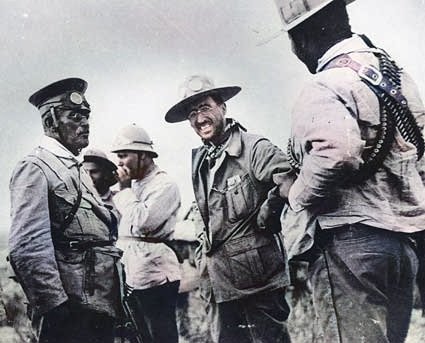Revolutionary Mexican 1 Peso Banknote
From the Collection: A banknote from the State of Chihuahua in Mexico
By 1914 Mexico had been undergoing a civil war for four years, first with a mostly united front against the aging dictator Porfirio Diaz followed by a fragmentation of various rebel factions against each other as well as President Madero’s new government. When General Victoriano Huerta, an officer retained by Madero from the Diaz regime, seized control of the country via a coup in 1913 the rebel factions allied once again to overthrow the despotic Huerta.
As the various military factions within Mexico consolidated their hold over their respective territories and fought against Huerta’s Federal Army, may would issue their own currencies, a mark of their refusal to consider any element of the government, or the other revolutionary factions, legitimate. The note seen here is an example issued in the State of Chihuahua, a desert region near the Texas and New Mexico border that was controlled by General Francisco “Pancho” Villa and his Division del Norte.
A red, hand-stamped seal of the Tesorería General Del estado Chihuahua, or the General Treasury of the State of Chihuahua, seen on the obverse
Printed in 1914, the note features the images of both assassinated President Francisco Madero on the left and the murdered Governor of the State, Abraham Gonzales, on the right. The text on the note states:
EL ESTADO DE CHIHUAHUA
PAGARA
AL PORTADOR EN EFECTIVO
UN PESO
CONFORME AL DECRETO MILITAR
DE FECHA 10 DE FEBERO DE 1914
CHIHUAHUA,
CHIHUAHUA, MEXICO
Translated, this reads as:
THE STATE OF CHIHUAHUA
WILL PAY TO
TO THE BEARER IN CASH
ONE PESO
ACCORDING TO MILITARY DECREE
DATED FEBRUARY 10, 1914
CHIHUAHUA,
CHIHUAHUA, MEXICO
The reverse of the banknote features an illustration of the Chihuahua State Capitol Building in the city of Chihuahua, as well as a hand-stamped red seal of the General Bank of the State of Chihuahua on the left. A hand stamped control number, also in red, is opposite the seal on the right side.
General Huerta (left) speaks with President Madero before his putsch. General Villa has his back to the camera.
The banknote displays a notable lack of security features aside from the hand stamped seal, with not watermark present. This note and those like it were issued by Panch Villa’s regional government from 1914 to 1915, after which Villa’s satus declined as Huerta was ousted and his resistance became more of a guerilla rebellion. This would spill over into the United States in 1916, prompting an American intervention against him, and by 1920 with the fall of his rival, President Venustiano Carranza, Villa offered recognition of the new government and requested amnesty, which was granted. He would retire to a hacienda in Canutillo, and would be assassinated in 1923.
The banknote seen here is an interesting reminder of a turbulent period in Mexican history, as well as a relic related to one of the best known figures of Mexican history within the United States.


